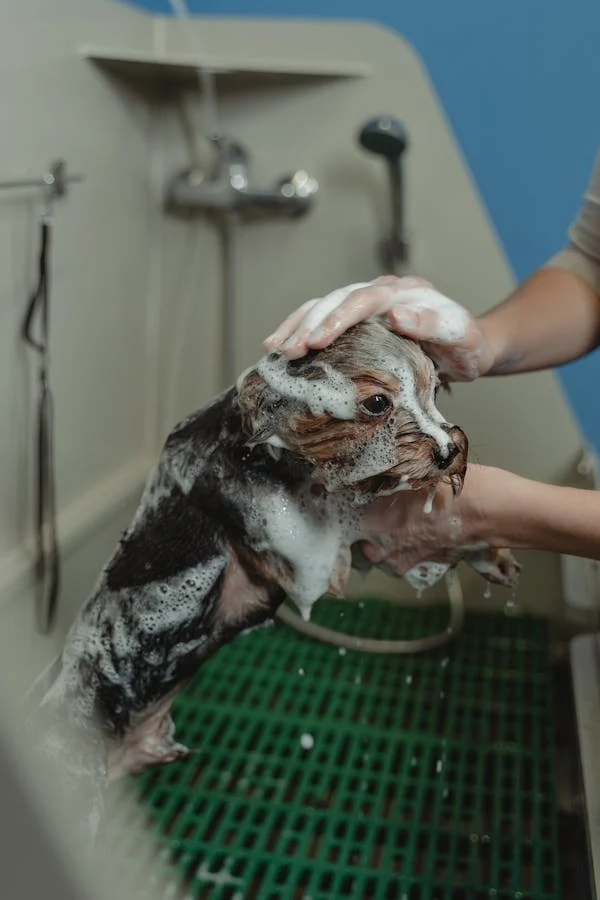Grooming your dog is essential for their health and happiness. The right grooming tools make the process easier and more effective.
Here’s a breakdown of the basic grooming equipment every dog owner should have.
Brushes and Combs
A good brush is the foundation of dog grooming. Different brushes cater to various coat types.
- Slicker Brush: Perfect for removing mats and tangles, especially in long-haired breeds.
- Bristle Brush: Ideal for short-haired dogs. It helps distribute natural oils and adds shine.
- Pin Brush: Great for fluffy coats. It gently detangles and removes loose fur.
Don’t forget a comb. A wide-toothed comb is excellent for detangling, while a fine-toothed comb is perfect for finishing touches.

Nail Clippers
Regular nail trimming is vital for your dog’s comfort. Choose the right nail clippers based on your dog’s size and temperament.
- Scissor Clippers: Best for larger dogs with thick nails.
- Guillotine Clippers: Suitable for small to medium-sized dogs.
- Electric Nail Grinders: A safe alternative that smooths nails without cutting.
Ensure you’re comfortable using these tools to avoid injury.

Grooming Scissors
Grooming scissors help you achieve a polished look. Use them to trim fur around sensitive areas.
- Straight Scissors: Perfect for basic trims.
- Curved Scissors: Ideal for rounding off edges.
- Thinning Shears: Great for blending and removing bulk.
Always opt for scissors with rounded tips for safety.
Bathing Supplies
Bathing your dog is a vital part of their grooming routine. The right bathing supplies make the experience enjoyable for both you and your pet.
Here’s what you need to keep your dog clean and healthy.
Dog Shampoo
Choose a high-quality dog shampoo tailored to your pet’s needs. Look for:
- Hypoallergenic Shampoo: Ideal for dogs with sensitive skin.
- Medicated Shampoo: Useful for dogs with skin conditions or allergies.
- Moisturizing Shampoo: Great for dry coats.
Always avoid human shampoos, as they can irritate your dog’s skin.
Conditioners
A good conditioner can improve your dog’s coat texture. It helps with detangling and adds moisture. Look for conditioners specifically designed for dogs.
These products can make grooming easier and leave your dog’s coat soft and shiny.
Bathing Tools
Bathing tools enhance the bathing experience. Consider the following:
- Bathing Mitts: These allow you to wash your dog while massaging their skin.
- Sponges: Soft sponges are great for gentle cleaning.
- Brushes: Use a bathing brush to lather shampoo and remove dirt effectively.

Towels and Drying Tools
After the bath, drying your dog is essential. Quick-dry towels are highly effective. They absorb water quickly and help keep your dog warm.
You can also consider a pet dryer for larger dogs or those with thick fur. These tools speed up the drying process and prevent your dog from getting cold.
Ear and Teeth Care
Regular ear and teeth care is crucial for your dog’s overall health. Keeping these areas clean helps prevent infections and dental issues. Here’s what you need for effective ear and teeth care.
Ear Cleaning Solutions
Maintaining clean ears is essential. Use a vet-recommended ear cleaning solution. These products help remove dirt and wax buildup.
Apply the solution according to the instructions. Gently massage the base of the ear to distribute it. Always wipe the outer ear with a soft cloth afterward.
Ear Cleaning Wipes
For quick cleaning, consider ear cleaning wipes. These are convenient and easy to use. Simply wipe the inside of your dog’s ear to remove debris.
They are perfect for regular maintenance between deep cleans. Look for wipes specifically designed for dogs to ensure safety.
Dog Toothbrush and Toothpaste
Dental hygiene is vital for your dog’s health. Start with a dog toothbrush. These are specially designed with softer bristles and angled heads for comfort.
Pair it with dog toothpaste, which is safe and comes in flavors dogs love.
- Importance of Dental Care: Regular brushing helps prevent plaque buildup and bad breath. Aim to brush your dog’s teeth several times a week.
Tips for Introducing Dental Hygiene
Introduce dental care gradually. Start by letting your dog taste the toothpaste. Then, gently brush a few teeth at a time.
Reward your dog with praise or treats to create a positive experience. Consistency is key to successful dental hygiene.

Flea and Tick Prevention
Flea and tick prevention is vital for your dog’s health. These pests can cause discomfort and lead to serious health issues. Having the right tools helps keep your pet protected.
Flea Combs
A flea comb is an essential tool for detecting and removing fleas. Use it regularly, especially during flea season.
- How to Use: Gently comb through your dog’s fur, focusing on areas like the neck and tail. Look for fleas or flea dirt. Clean the comb after each use to prevent reinfestation.
Topical Treatments
Topical treatments offer effective flea and tick prevention. These treatments are easy to apply and provide long-lasting protection.
- Types of Treatments: Look for options that are safe for your dog’s age and size. Follow the application instructions carefully.
Flea Collars
Flea collars are another option for preventing infestations. They release chemicals that repel fleas and ticks.
- Benefits of Flea Collars: These collars are easy to use and provide continuous protection. Choose a collar designed specifically for your dog’s size and breed.
Grooming Tables and Accessories
A grooming table makes the grooming process easier and more efficient. It provides a stable surface and helps keep your dog secure.
Here’s what you need to know about grooming tables and accessories.
Grooming Table
Investing in a grooming table is beneficial for both you and your dog. Look for a sturdy table that can support your dog’s weight. A non-slip surface is important to prevent accidents.
- Adjustable Height: Choose a table with adjustable height settings. This feature allows you to work comfortably without straining your back.
Restraints and Leashes
Using restraints and leashes keeps your dog safe during grooming. Grooming loops are commonly used to secure your pet.
- Types of Restraints: Look for adjustable loops that attach to the grooming table. This helps prevent your dog from jumping off.
Consider a slip lead or a grooming leash for extra control. These tools help you manage your dog’s movements effectively.
Additional Grooming Tools
In addition to the basic grooming supplies, several specialty tools can enhance your dog grooming routine.
These tools address specific needs and help keep your dog looking their best.
De-shedding Tools
De-shedding tools are essential for managing loose fur, especially in heavy shedders.
- Types of De-shedding Tools: Consider using a de-shedding brush or a rake. These tools effectively remove undercoat fur without damaging the top coat.
Using a de-shedding tool regularly can reduce shedding around your home and keep your dog’s coat healthy.
Grooming Gloves
Grooming gloves are a versatile option for brushing your dog. They allow you to bond with your pet while grooming.
- Benefits of Grooming Gloves: These gloves are gentle and effective for removing loose fur. They can also be used during bath time for massaging shampoo into your dog’s coat.
Grooming gloves are especially useful for dogs that are nervous about traditional brushes.
Specialty Tools for Specific Breeds
Different dog breeds have unique grooming needs. Investing in breed-specific grooming tools can make a big difference.
- Examples: For long-haired breeds, look for a dematting tool to tackle tangles. For short-haired breeds, a rubber brush can help remove loose fur and dirt.
Research your dog’s breed to find the best tools suited for their coat type and grooming requirements.
Conclusion
Grooming your dog is essential for their health and well-being. Having the right grooming equipment makes this task easier and more enjoyable.
By investing in basic tools like brushes, nail clippers, and grooming scissors, you set a solid foundation for grooming.
Bathing supplies, ear and teeth care products, and flea prevention tools are equally important. A grooming table and appropriate restraints ensure safety and comfort during grooming sessions.
Additional tools, such as de-shedding brushes and grooming gloves, cater to specific needs and enhance the grooming experience.
Always choose high-quality products designed for dogs to achieve the best results.
With the right equipment, you can keep your dog looking great and feeling their best. Regular grooming helps prevent health issues and strengthens your bond with your pet.
So, gather your grooming tools and make grooming a regular part of your dog’s care routine!
Related Posts:
Home remedies for separation anxiety in dogs.
The glamour of mixed dog breeds with poodle
FAQs
1. What basic grooming tools do I need for my dog?
You need essential tools like a brush, nail clippers, grooming scissors, and a dog shampoo. These tools help maintain your dog’s coat, nails, and overall hygiene.
2. How often should I groom my dog?
The frequency of grooming depends on your dog’s breed and coat type. Generally, long-haired dogs require grooming every few days, while short-haired breeds can be groomed weekly.
3. Can I use human shampoo on my dog?
No, human shampoos can irritate a dog’s skin. Always use shampoos specifically formulated for dogs to ensure their safety and comfort.
4. What are the benefits of using a grooming table?
A grooming table provides a stable surface and adjustable height, making grooming easier for both you and your dog. It also helps keep your pet secure during the grooming process.
5. How can I prevent fleas and ticks on my dog?
Regularly use flea and tick prevention products such as topical treatments, flea collars, and flea combs. Consult your veterinarian for the best options for your dog.
6. What should I do if my dog doesn’t like grooming?
Start slowly and create a positive experience. Use treats and praise to reward your dog. Gradually introduce grooming tools and keep sessions short to build comfort over time.
7. Do I need special tools for specific breeds?
Yes, different breeds have unique grooming needs. Research your dog’s breed to find tools suited for their coat type, such as de-matting tools for long-haired dogs.
8. How can I maintain my dog’s dental health?
Use a dog toothbrush and toothpaste specifically designed for pets. Aim to brush your dog’s teeth several times a week to prevent plaque buildup and dental issues.

